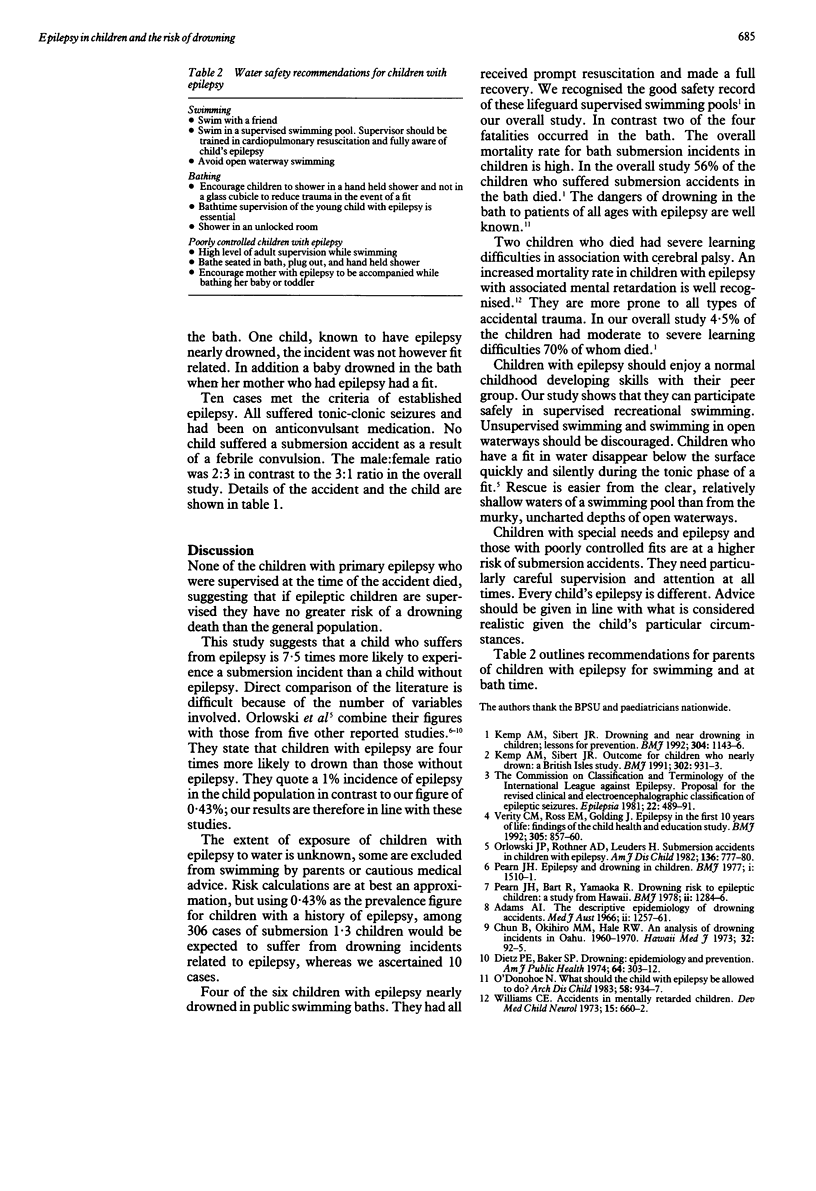Abstract
To clarify the risks of drowning for children with epilepsy we have studied the records of the 306 children who drowned or nearly drowned in the UK in 1988 and 1989. Ten children with incidents related to epilepsy presented over the study period, four of whom drowned. Children with epilepsy had a higher incidence of submersion accidents but no child participating in supervised swimming drowned. Two children died in the bath. Five children had special needs. We conclude that children with epilepsy can enjoy swimming with a friend in a lifeguard supervised swimming pool. They should be encouraged to shower in a non-glass cubicle rather than have a bath. The bathroom should remain unlocked. Children with poorly controlled epilepsy or associated learning difficulties are at a higher risk from all accident trauma. They need a very high level of supervision while swimming and advice should be given on an individual basis according to what is considered realistic for that child.
Full text
PDF

Selected References
These references are in PubMed. This may not be the complete list of references from this article.
- Adams A. I. The descriptive epidemiology of drowning accidents. Med J Aust. 1966 Dec 31;2(27):1257–1261. doi: 10.5694/j.1326-5377.1966.tb91982.x. [DOI] [PubMed] [Google Scholar]
- Chun B., Okihiro M. M., Hale R. W. An analysis of drowning incidents on Oahu, 1960-1970. Hawaii Med J. 1973 Mar-Apr;32(2):92–95. [PubMed] [Google Scholar]
- Dietz P. E., Baker S. P. Drowning: epidemiology and prevention. Am J Public Health. 1974 Apr;64(4):303–312. doi: 10.2105/ajph.64.4.303. [DOI] [PMC free article] [PubMed] [Google Scholar]
- Kemp A. M., Sibert J. R. Outcome in children who nearly drown: a British Isles study. BMJ. 1991 Apr 20;302(6782):931–933. doi: 10.1136/bmj.302.6782.931. [DOI] [PMC free article] [PubMed] [Google Scholar]
- Kemp A., Sibert J. R. Drowning and near drowning in children in the United Kingdom: lessons for prevention. BMJ. 1992 May 2;304(6835):1143–1146. doi: 10.1136/bmj.304.6835.1143. [DOI] [PMC free article] [PubMed] [Google Scholar]
- O'Donohoe N. V. What should the child with epilepsy be allowed to do? Arch Dis Child. 1983 Nov;58(11):934–937. doi: 10.1136/adc.58.11.934. [DOI] [PMC free article] [PubMed] [Google Scholar]
- Orlowski J. P., Rothner A. D., Lueders H. Submersion accidents in children with epilepsy. Am J Dis Child. 1982 Sep;136(9):777–780. doi: 10.1001/archpedi.1982.03970450019004. [DOI] [PubMed] [Google Scholar]
- Pearn J. M. Epilepsy and drowning in childhood. Br Med J. 1977 Jun 11;1(6075):1510–1511. doi: 10.1136/bmj.1.6075.1510. [DOI] [PMC free article] [PubMed] [Google Scholar]
- Pearn J., Bart R., Yamaoka R. Drowning risks to epileptic children: a study from Hawaii. Br Med J. 1978 Nov 4;2(6147):1284–1285. doi: 10.1136/bmj.2.6147.1284. [DOI] [PMC free article] [PubMed] [Google Scholar]
- Verity C. M., Ross E. M., Golding J. Epilepsy in the first 10 years of life: findings of the child health and education study. BMJ. 1992 Oct 10;305(6858):857–861. doi: 10.1136/bmj.305.6858.857. [DOI] [PMC free article] [PubMed] [Google Scholar]
- Williams C. E. Accidents in mentally retarded children. Dev Med Child Neurol. 1973 Oct;15(5):660–662. doi: 10.1111/j.1469-8749.1973.tb05179.x. [DOI] [PubMed] [Google Scholar]


